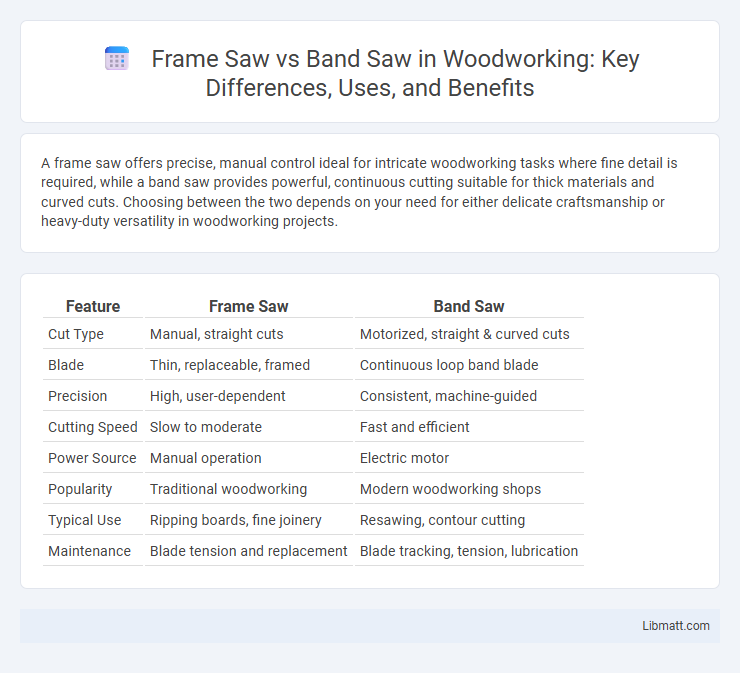A frame saw offers precise, manual control ideal for intricate woodworking tasks where fine detail is required, while a band saw provides powerful, continuous cutting suitable for thick materials and curved cuts. Choosing between the two depends on your need for either delicate craftsmanship or heavy-duty versatility in woodworking projects.
Table of Comparison
| Feature | Frame Saw | Band Saw |
|---|---|---|
| Cut Type | Manual, straight cuts | Motorized, straight & curved cuts |
| Blade | Thin, replaceable, framed | Continuous loop band blade |
| Precision | High, user-dependent | Consistent, machine-guided |
| Cutting Speed | Slow to moderate | Fast and efficient |
| Power Source | Manual operation | Electric motor |
| Popularity | Traditional woodworking | Modern woodworking shops |
| Typical Use | Ripping boards, fine joinery | Resawing, contour cutting |
| Maintenance | Blade tension and replacement | Blade tracking, tension, lubrication |
Introduction to Frame Saws and Band Saws
Frame saws feature a wooden or metal frame holding a narrow blade under tension, ideal for precise, fine woodworking tasks such as resawing or cutting curves. Band saws use a continuous loop blade running on wheels, offering versatility in cutting thick lumber, ripping, and intricate shapes with smooth, consistent cuts. Your choice depends on the need for detail and control with a frame saw or power and efficiency with a band saw.
Historical Evolution of Frame Saws and Band Saws
Frame saws originated in the medieval period, primarily used for precise woodworking and characterized by a narrow blade tensioned within a wooden frame. Band saws emerged in the 19th century with the invention of continuous metal bandsaw blades, revolutionizing cutting efficiency by enabling continuous, uniform cuts in lumber and metal. The evolution from frame saws to band saws marked a significant technological advancement in saw design, improving speed, precision, and the ability to handle a variety of materials in industrial applications.
Design and Construction Differences
Frame saw features a rigid rectangular wooden frame holding a narrow blade under tension, enabling precise, fine cutting with minimal blade deflection. Band saw uses a continuous looped steel blade running over two or more wheels, allowing for smooth, continuous cuts and the ability to handle curves and irregular shapes efficiently. Frame saws are typically manual with simple construction, while band saws incorporate electric motors and complex wheel systems for automated cutting performance.
Cutting Mechanism and Precision
A frame saw uses a taut blade held in a rectangular frame, allowing for controlled, precise cuts ideal for delicate woodworking tasks. Band saws employ a continuous loop blade running on wheels, offering smooth, consistent cutting through thicker materials with less effort. Your choice between these saws should consider the frame saw's detailed accuracy versus the band saw's efficiency and versatility in handling various materials.
Material Compatibility and Versatility
Frame saws excel in cutting hardwoods and softwoods with precision due to their thin, tensioned blades ideal for fine, detailed work. Band saws offer superior versatility by handling a wide range of materials, including metal, plastic, and thick lumber, thanks to adjustable blade types and speeds. Both tools provide distinct advantages: frame saws are optimal for delicate joinery, while band saws accommodate diverse cutting needs across various materials.
Power Source and Energy Efficiency
Frame saws operate manually, relying on human power, which results in zero energy consumption and maximum energy efficiency. Band saws use electric motors, consuming electrical energy that varies based on motor size and usage frequency, impacting overall energy efficiency. Choosing between the two depends on available power sources and desired energy savings.
Maintenance and Durability Comparison
Frame saws require frequent blade tension adjustments and periodic replacement of cords or leather components, with wooden frames prone to warping over time, impacting durability. Band saws feature continuous steel blades with motorized tension systems that demand regular blade sharpening or replacement, while their metal frames offer superior structural longevity and reduced maintenance needs. The choice between the two hinges on balancing the traditional frame saw's simpler upkeep against the band saw's enhanced durability and consistent performance in industrial settings.
Application Scenarios: When to Use Each Saw
Frame saws excel in fine woodworking tasks requiring precise, controlled cuts, making them ideal for traditional joinery and delicate furniture restoration. Band saws handle a wider range of materials and thicknesses, excelling in curved cuts, resawing large timber, and processing irregular shapes with speed and efficiency. Your choice depends on the project's complexity; use a frame saw for detailed, intricate work and a band saw for versatile, heavy-duty cutting applications.
Cost Considerations and Budget Impact
Frame saws generally have a lower upfront cost compared to band saws, making them an affordable option for budget-conscious woodworkers. Band saws, however, often require higher initial investment but offer faster cuts and greater versatility, which can lead to long-term savings on labor and material waste. Your choice should balance immediate budget constraints against potential productivity gains provided by band saws.
Choosing the Right Saw: Frame Saw vs Band Saw
Frame saws provide precise control and are ideal for fine woodworking tasks requiring intricate cuts, using a thin blade tensioned within a wooden frame. Band saws feature a continuous loop blade and excel in cutting curves, ripping lumber, and resawing large boards efficiently in cabinetry and furniture making. Selecting between a frame saw and a band saw depends on the need for maneuverability and finesse versus power and versatility in cutting various wood sizes.
Frame saw vs band saw Infographic

 libmatt.com
libmatt.com